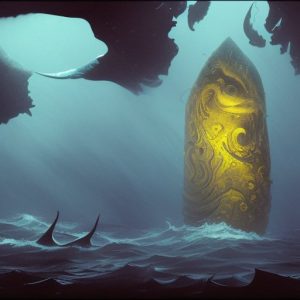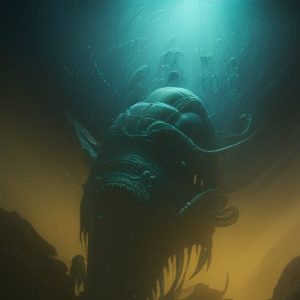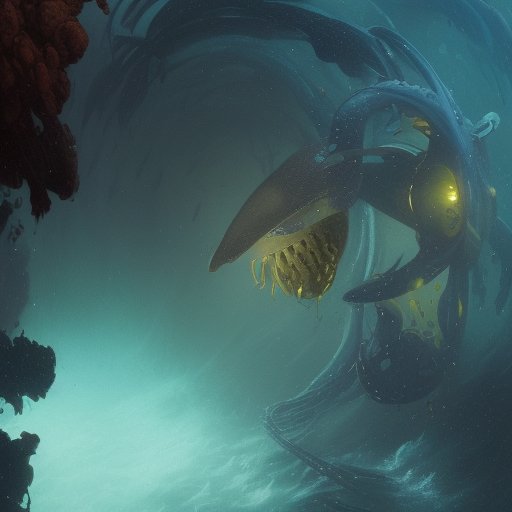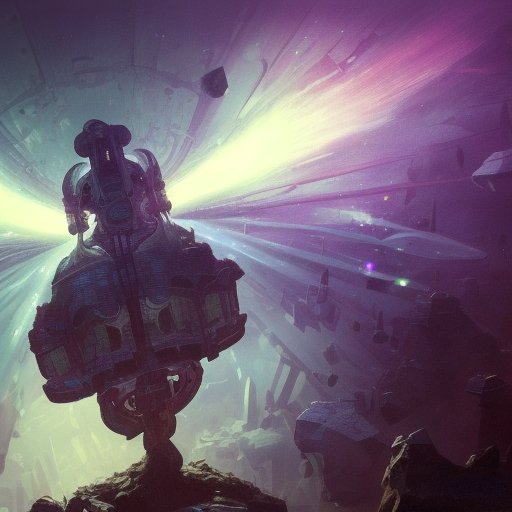
The deep sea has always been a place of mystery and intrigue. With strange and eerie creatures lurking in its black depths, it’s no wonder that the ocean has captured humanity’s imagination for centuries. In this article, we set out to demystify the spooky creatures of the deep and explore the unknown depths of the ocean. We dive into the unique ecosystem and how it functions, discuss the challenges of studying life in the deep sea, and look at the technology used to bridge the gap between the human world and the underwater one. Join us as we venture into the unknown depths and explore the monsters of the deep.
I. Introduction
The vast ocean is like a big, creepy dungeon filled with eerie creatures that spark the imagination of every human being. Since the beginning of time, humans have been terrified and fascinated by their unknown depths. There is a mysterious quality to the sea that makes even the bravest among us tremble. But what about the creatures lurking underneath the waves? What secrets do they keep?

In this article, we dive into the unknown depths of the ocean, seeking to uncover the secrets and mysteries of the deep sea and its creatures. We aim to demystify these spooky monsters by exploring their unique ecosystem and how it functions. We will take a closer look at the technology used to study them, as well as the challenges of understanding life in the deep sea.
Throughout history, there have been tales of mythical sea creatures, and while some may dismiss them as mere legends, it is impossible to deny the mysterious beauty and complex nature of life in the ocean. The vastness of the ocean is mind-boggling, and space explorers recognise the similarities between underwater and space exploration.
Our curiosity is insatiable, and as we learn more about the creatures living in the deep sea, we begin to realise how much we still do not know. With new technology comes new knowledge, and as we venture further into the unknown depths of the ocean, we are sure to make incredible discoveries.
Join us on this adventure as we dive into the mystery surrounding the ocean and look to demystify the spooky creatures of the deep. Let’s explore the unknown shores of the sea, and discover what wonders lay underneath those waves.
II. The Unknown Depths
The ocean is a vast and mysterious landscape that covers over 70% of our planet. While we have sent men to space, the deep sea remains largely unexplored. It starts just a few feet beneath the surface, but quickly becomes one of the most dangerous environments on earth. The pressure at this depth is incredible, and the cold is enough to freeze almost anything. It is a hostile and unforgiving place, and yet there is still so much we don’t know about it.

The unknown depths of the ocean are a source of intrigue and awe for many. Still, much of what lies beneath remains an enigma. Scientists speculate that up to 95% of the ocean has not yet been explored, which leaves a great deal of space for new discoveries.
Interestingly, space exploration and ocean exploration have many similarities. For example, underwater caves can be just as deadly as the vacuum of space, and the manipulation of pressure and atmosphere is just as important. In the same way that space offers insights into the fundamental nature of the universe, exploring the ocean can teach us about the history of our planet, how life evolved, and what life forms exist beyond our planet.
However, exploring the ocean comes with its own set of unique challenges. Despite advances in technology, the ocean remains difficult to navigate, and its depths remain largely uncharted. Sending missions into the deep sea is fraught with danger, and the idea of exploring an ecosystem so different from our own is a daunting and humbling prospect.
So, as we continue to push the boundaries of exploration and expand our understanding of the world around us, we must remember that the unknown depths of the ocean are a crucial piece of our planet’s puzzle. The mysteries they hold are waiting to be uncovered, and it is up to us to unlock them.
III. Monsters of the Deep
As we plunge deeper into the ocean, the monsters that lurk beneath the waves seem to grow more ominous and terrifying. The deep sea creatures are the stuff of nightmares: weird, creepy, and quite frankly, awe-inspiring. The creatures are adapted to survive in the harsh and unusual environment of the deep sea, where the ambient pressures reach staggering levels.

One of the most well-known deep sea creatures is the giant squid. These elusive creatures, with their long and creepy arms and tentacles, are a sight to behold. Another creature that often comes to mind is the anglerfish, known for their ability to lure prey with their bioluminescent lures. The viperfish, with its sharp and pointy teeth, is also an impressive but spooky deep sea creature.
The gulper eel is another strange creature that can be found in the deepest parts of the ocean, thanks to its ability to swallow prey larger than its own body. The fangtooth is another deep sea creature that sports an eerie set of teeth, capable of tearing through anything that gets in its way.
Some deep sea creatures are downright odd-looking, such as the blobfish, which has become an unofficial mascot of the deep sea due to its unusual appearance. One of the most infamous creatures is the frilled shark, with its snake-like appearance and rows of razor-sharp teeth.
It’s not just the creatures themselves that are intriguing; it’s the unique way they adapt to their environment, such as the jellyfish-like siphonophores, which are colonies of specialised individuals working together as one organism.
The deep sea creatures are a puzzle, a mystery to unravel, a chance to expand our knowledge of the world around us. Their unique characteristics are awe-inspiring, and while they may be scary at times, they are also deserving of our respect and admiration.
IV. Secrets of the Underwater World
Beneath the surface, in the dark depths of the ocean, a world unlike any other exists. With towering kelp forests and sparkling coral reefs, the underwater world is home to an amazing array of creatures, each with their own unique adaptations that allow them to survive and thrive.

One of the most fascinating aspects of the underwater world is how it functions. The interconnectedness of the ecosystem is awe-inspiring, and the balance that life on this planet relies on is nothing short of remarkable. From the microscopic plankton all the way up to the massive, mysterious whales, each organism plays a vital role in the perpetuation of life in the ocean.
The creatures of the deep have evolved to overcome the harsh conditions that come with living in a completely different environment. The adaptations of these creatures make them ready for anything the ocean can throw at them. From bioluminescent jellyfish to angler fish with their glowing lures, there is never a dull moment in the ocean.
One of the most wondrous aspects of the underwater world is the incredible diversity of life found there. The colours, shapes, and sizes of the creatures are beyond imagination. The vibrant and gorgeous hues of coral and sea anemones provide a bright and colourful display against the dark blue waters, while schools of fish create a sense of harmony as they swim in rhythm. Every creature has its own set of behaviours, whether it’s the majestic grace of a whale, or the incredible hunting tactics of a shark.
The secrets held by the underwater world are endless, and the more we learn about them, the more fascinating and complex the ocean seems. It is a world full of beauty, colour, and mystery; a place where life thrives despite the odds. As we slowly unravel the secrets of the underwater world, we come to realise that it might hold more answers about our own evolution as a species than we could ever imagine.
V. The Science of Studying Deep Sea Creatures
Studying deep sea creatures is no easy task, but modern technology has made it easier to explore and understand the mysterious underwater world. To study these spooky monsters, scientists use a variety of high-tech tools and techniques.

One such tool is the remotely operated vehicles, also known as ROVs. These machines can dive to the depths of the ocean and capture footage of the creatures in their natural habitat. With advanced cameras, researchers can record underwater footage in high definition, allowing them to examine the creatures’ behaviours and characteristics more closely.
In addition to ROVs, researchers also use underwater drones or autonomous underwater vehicles (AUVs) to collect biological and chemical samples. These samples can then be analysed in the laboratory to better understand the creatures and their unique environment.
Another important tool is the hydrophone, which allows researchers to listen to the sounds of the ocean. From whale songs to the vocalisations of other deep sea creatures, these sounds can reveal the behaviours of the creatures and even help scientists locate them.
One thing to consider is the pressure at the bottom of the ocean. With depths that can reach 11 kilometres, the pressure is immense. Scientists must develop instruments that can withstand this pressure and collect data from the deep.
Studying deep sea creatures comes with some unique challenges. Due to the lack of sunlight, deep sea creatures lack pigments that would make them colourful, so they have developed unique adaptations to help them survive their dark environment. Another notable challenge is understanding how the pressure and temperature affect the biology and chemistry of the creatures.
Through the advancements in technology, the study of deep sea creatures continues to expand, and researchers are uncovering new discoveries every day. With new robotic technologies and analytical tools, our understanding of the mysterious and spooky creatures of the deep sea is sure to continue to grow.
VI. The Future of Underwater Exploration
The exploration of the deep sea is just beginning, and with each dive, new discoveries are made. As technology continues to evolve, so too does our ability to understand and explore the mysteries of the ocean. Future missions to explore the underwater world will likely employ new and exciting technologies to help us navigate and understand the deep sea environment.

One of the most promising technologies for underwater exploration is robotics. Robots can be used to study areas of the ocean that are too dangerous for humans to reach or too deep for divers to withstand the pressure. With advanced robotic technology, we will be able to explore deeper and farther into the unknown depths of the ocean.
Another exciting development is the use of artificial intelligence (AI) to help us make sense of the vast amounts of data collected during underwater exploration missions. AI can help analyse data and identify patterns that human scientists may overlook, leading to new discoveries and advancements in our understanding of the ocean.
Additionally, improved communication technology will enable scientists on board research vessels to communicate more effectively with divers and drones exploring the deep sea. With clearer communication, researchers can better direct their exploration and gather more accurate data.
Looking to the future, we can anticipate more advanced methods of underwater exploration, such as autonomous vehicles and underwater drones. These technologies will allow us to explore larger areas of the ocean and reach depths that would otherwise be impossible to reach. We may even be able to discover entirely new species of creatures that have yet to be documented by humans.
Ultimately, the future of underwater exploration is limited only by our imagination and the technology we have to explore. As we continue to push the boundaries of what is possible, we are sure to discover incredible new wonders and mysteries in the deep sea.
VII. Conclusion
As we conclude our journey into the deep sea and its spooky creatures, one thing is clear: there is still so much we do not know. The ocean remains a mystery, and the creatures that live within it are just as enigmatic. However, despite the fear and mystery that surrounds it, the sheer beauty and complexity of life in the ocean is astounding.

Through the use of new technology and continued exploration, we are sure to uncover more incredible discoveries in the future. As we learn more about the deep sea, we have the chance to gain insight into aspects of our planet we have not yet seen.
We must also do our part in preserving the ocean and its creatures. The ocean is not only a source of wonder and fascination but also vital to sustaining life on this planet. It is our responsibility to take care of it and ensure that it remains a healthy and thriving ecosystem.
As we reflect on our journey, we cannot help but feel a sense of awe and wonder at the vastness of the ocean and the creatures that live within it. The ocean and its creatures are just as much a part of the universe as anything else, and we are privileged to have the opportunity to study and explore it.
We hope that this article has helped to demystify the spooky creatures of the deep and inspired you to appreciate the beauty and complexity of the ocean. Join us as we continue to explore the unknown depths of the ocean and uncover the secrets it still holds.






